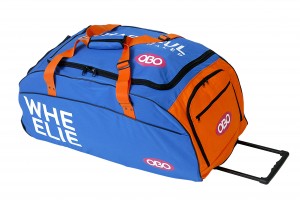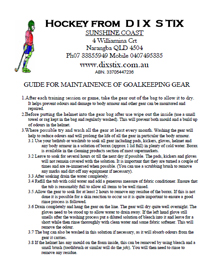While at a tournament and a long way from home it can be very off putting to not have equipment that is needed to do the job and perform at your highest level. For some of us (me too) representative duties can be quite a daunting task given that it may well be the first time that you are out of direct contact with your personal trainers/managers/equipment suppliers (Mum and Dad) (Long suffering wife in my case) Your team is relying on you, and your gear lets you, and them down………………….sometimes duct tape just don’t do the job!
To help with this I have come up with a list of contents for an effective “tour bag” for a keeper. (At least it’s what lives in my bag)
1/ Pads and Kickers
2/ Gloves and inners if worn
3/ Body Armour including Arms/Elbows
4/ Helmet
5/ Padded shorts/Girdle
6/ Stick
7/ Groin/Pelvic protector
8/ Spares Kit
9/ Consumables
10/ Tools
11/ Team supplies

Preparation of all the gear
1/ Pads and kickers.
Make sure that the foam is in good condition with all seams secure, straps in good nick with stitching/rivets secure and no buckles/clips rusty/broken. A new set of kicker straps is often a good investment if your’re playing schedule is heavy.
2/ Gloves.
Check for any tears holes etc in the foam and that any straps must be in good nick and clean the damned things (unless you really want your hands to smell like feet!) Wash in a powdered borax solution and rinse well if that doesn’t remove all the pong, try a weak bleach solution, again rinse well and allow to dry out of direct sunlight. Inners if you wear them should be washed with your over-shirts and helmet comfort pads.
3/ Body armour including elbows/arms.
If you wear the segmented fabric covered type, do up the straps and place it in the washing machine for a gentle cycle with a little laundry detergent and listen to it cycle. When the machine is on spin make sure that no part of the armour is above the rim of the drum and touching the stationary body of the machine ‘cause this will burn the fabric and embarrass the hell out of you. Place the armour on a coat hanger and allow it to dry out of direct sunlight. If you wear a foam chest-plate, treat it just the same as your pads and kickers.
4/ Helmet.
It doesn’t matter what type/brand or style you wear, the grill must be in good condition and firmly fastened to the shell of the helmet, all screws must be tight and clips in place and unbroken. Just for hygiene’s sake wash the helmet in a weak bleach solution and work the solution into the foam. Rinse well in clean water and allow to dry before packing the helmet away. I shudder when I see the inside of some helmets that are years old and never been washed. Make sure the comfort liner is clean and in place.
5/ Padded shorts or girdle and cover-shorts.
Put them in the washing machine with your body armour, inspect after washing for cuts, tears or broken seams. Replace of reposition missing/moved foam pads and make sure that the pockets that hold them are tight.
6/ Stick.
No chips, cracks or sharp edges. Grip in good condition and secured.
7/ Groin/Pelvic protector.
For gawd’s sake give the poor thing a wash (throw it in with the armour and shorts) then make sure the elastic is good and that any clips/buckles are whole.
Additional stuff that’s gotta be packed
(Spares Kit? Or what lives in my bag for my gear)
A ½ set of kicker straps (2 long 2 short toe straps)
A set of “StrapSecure” (webbing loops that stop the front toe strap riding up over my boot toe)
1 long pad strap with buckle (can be cut to make a kicker ankle strap with buckle)
Small assortment of helmet screws posts and clips to suit my helmet.
Consumables
Stuff that my team-mates can use to solve all their little problems. This lot lives in a “Tupperware” container in a side pocket of my bag.
A roll of duct tape
A roll of strapping tape
A roll of insulation tape
2 spare stick grips
2 small tubes (1ml) of cyano-acetate cement
A small tube (25ml) of contact cement
A bottle of Ibuprofen tablets
A tube of ‘30+’ sunscreen
A bottle of nail-polish
A bottle of acetone (25ml max)
6 heavy duty zip ties at least 18” long
My good lady wife (also a keeper) carries tampons (I don’t, go figure)
Tools. (In the hold only on flights)
A box-cutter
Star and flat blade screw drivers
Pair bull-nose pliers with cable/wire cutters
Team supplies.
1 dozen practice balls in a cage
2 match balls
2 “Face-off” masks
Explanation of “Consumables”
Do I really have to explain the three tapes?
Every “fieldy” decides the fatter the grip the better the control.
Super Glue in 1ml size is a single use, throw away that can stick most stuff to other stuff.
Contact glue is great for shoes, foam, or any porus material.
Hmm… Drugs…. fixes headaches and inflammation (strains and sprains)
Sunscreen: Great stuff if you play in daylight outside.
No. I’m not going soft. Fixes chips in composite sticks (no moisture entry causing delamination). Apply to helmet screws before tightening to act as a thread lock. Great for marking balls. The correct shade goes well with your cocktail dress (?)
An all purpose cleaner, works on balls, foam, fingernails, removes the adhesive that the three tapes may leave behind removes grease before using glue to stick stuff together.
Sooo handy (known as “flexi cuffs” by police) at a pinch can even replace kicker straps. Let your imagination run wild.
I’m just not going there for the last item.
Explanation of “Tools”
Good sharp blade for cutting flexi cuffs, tape and anything else that needs to be shorter than it is
How else are you going to tighten helmet screws and service the team bus?
For the removal of fingernails under questioning (Oops. family forum) holding of small items with force. Just getting a grip on things that need to be gripped.
Explanation of “Team supplies”
Have you ever tried “warming up” to find that the coach left the balls at the hotel? This is a problem you don’t want and your responsibility to avoid by taking action yourself by providing “warm up” balls.
Don’t want to be seen as the poor country cousins by only having a crappy old ball for the match, get a couple of “kookas” and keep them clean using the acetone.
“Post men” have far more confidence when they have a “face off” to hide their fear behind. They have been known to prevent contamination of the playing surface by blood.
